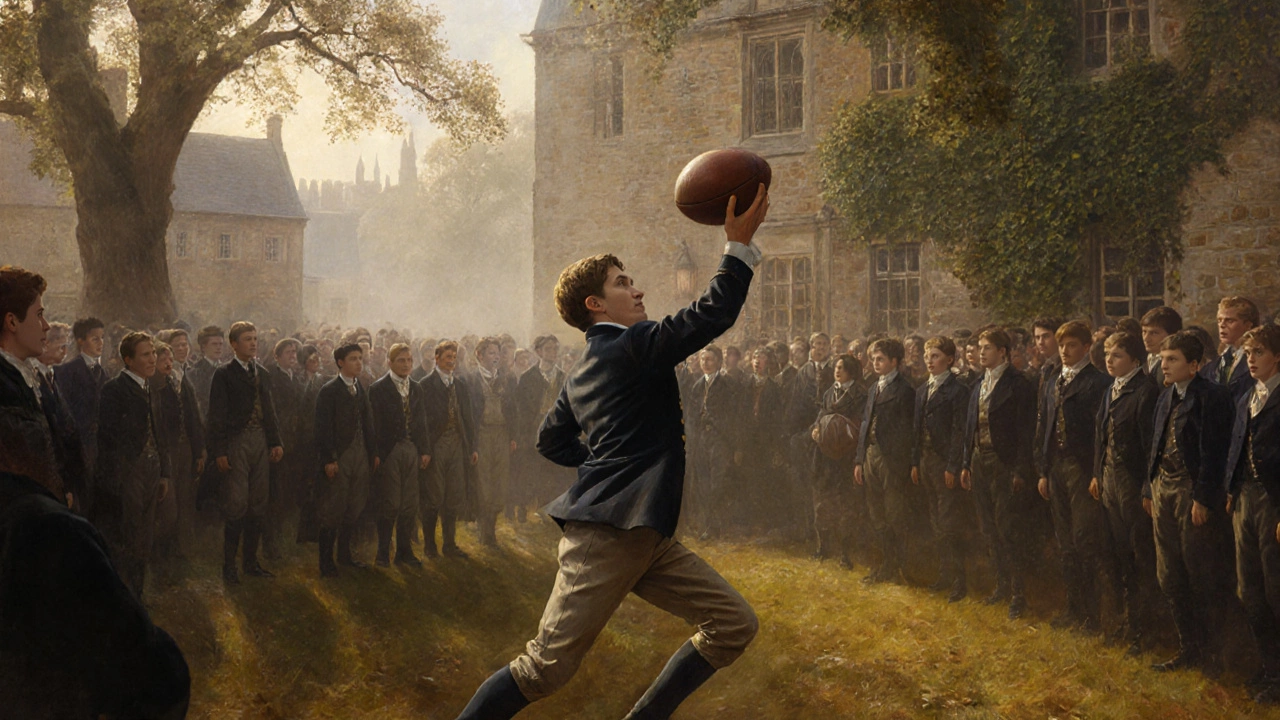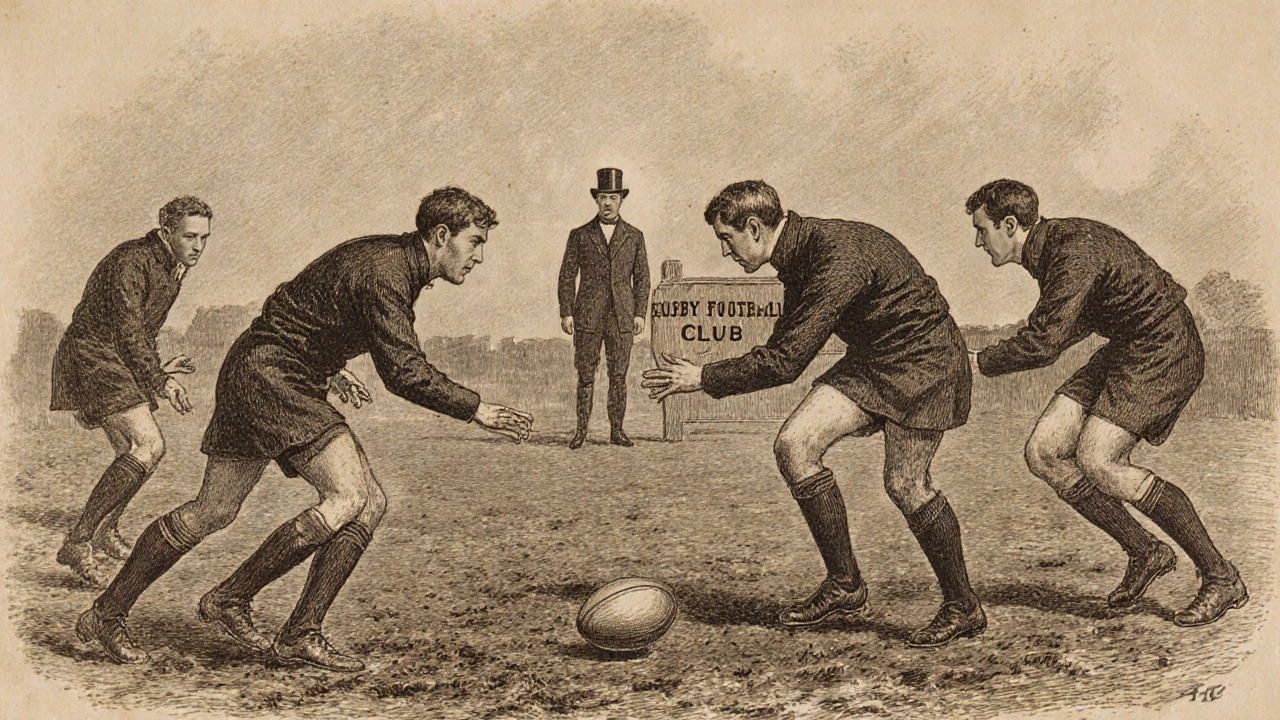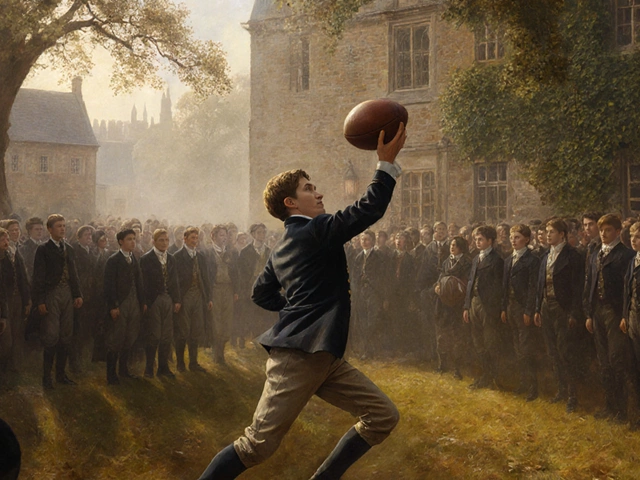
Rugby Fixtures November 17, 2025
Why Is Rugby Called Rugby? The Real Story Behind the Name
Rugby Origins Quiz
Ever wondered why a sport played with an oval ball, tackled like a wrestling match, and watched by millions across the globe is called rugby? It’s not some random word pulled from a hat. The name comes from a single school in England, a boy who broke the rules, and a moment that changed sports forever.
The School That Gave Rugby Its Name
In 1823, at Rugby School in Warwickshire, England, a 16-year-old boy named William Webb Ellis picked up a football during a match and ran with it. No one had done that before. Back then, football games were messy, rule-light affairs where kicking was the norm. Handling the ball was frowned upon, if not outright banned.
Webb Ellis didn’t just break a rule-he broke the mold. Whether he actually did it or if the story was made up later doesn’t matter as much as what happened after. The kids at Rugby School started allowing handling the ball in their version of football. It spread. By the 1840s, they had written down their own rules. And by the 1870s, when clubs outside the school wanted to play the same way, they called it ‘Rugby football’-named after the place where it was born.
Rugby Football vs. Association Football
Before rugby became its own thing, there was just ‘football’. Different schools had different rules. Some let you kick, some let you carry, some didn’t allow any handling at all. In 1863, the Football Association (FA) was formed in London to standardize the game. They banned handling the ball completely. That version became what we now call soccer.
The schools and clubs that liked carrying the ball? They didn’t join the FA. They formed their own group in 1871: the Rugby Football Union. The name stuck. ‘Rugby football’ became ‘rugby’ for short. The split was clean: one game for kickers, one for runners. And the name? It came straight from the school where it all started.
How the Name Spread Around the World
Rugby didn’t stay in England. British soldiers, sailors, and teachers took it with them. By the 1880s, rugby was being played in Australia, New Zealand, South Africa, and even parts of Canada. In places like New Zealand, the game exploded. The All Blacks became legends. In South Africa, it became tied to national identity. In Australia, they developed their own version: rugby league.
But everywhere it went, it kept the name. ‘Rugby’ wasn’t just a game-it was a brand. Even when countries added their own twists, like the 13-player version in league or the faster-paced sevens variant, they still called it rugby. Why? Because the origin was too strong to change. The name carried history, tradition, and a sense of belonging to something older than modern sports.

Myths and Misconceptions
You’ll hear people say Webb Ellis invented rugby. He didn’t. He didn’t even invent running with the ball-other schools had similar stories. But his name became attached to the moment that sparked the formal split. The Rugby School archives don’t have a written record of the event until decades later. That doesn’t mean it didn’t happen. It just means the story grew as the game did.
Some think ‘rugby’ comes from a person’s last name. It doesn’t. It comes from the town. Rugby, Warwickshire, is a real place. It’s still there. You can visit Rugby School today. The statue of Webb Ellis stands near the old playing field. The school still plays a version of the original game every year.
Why the Name Still Matters Today
Think about how many sports are named after places: baseball (from the English game), hockey (from the French word for stick), or tennis (from the French ‘tenez’). But rugby is one of the few where the name is literally the name of a school. That’s rare. It’s not named after a person, a rule, or a shape. It’s named after a building and the kids who played inside it.
That’s why, even in 2025, when you see the Rugby World Cup, the Six Nations, or a local club match in Bristol, you’re watching something that started with a boy picking up a ball in a 19th-century English classroom. The name isn’t just a label. It’s a reminder that sports aren’t just rules-they’re stories. And rugby’s story began with one act of rebellion.

What Happened to the Original Ball?
Here’s a fun twist: the ball wasn’t always oval. Early rugby balls were made from pig bladders, stuffed into leather casings. They were roundish-until someone realized that an oval shape was easier to carry and pass. The shape stuck. By the 1870s, manufacturers started making balls to a specific oval design. Today’s rugby ball still follows that shape, and it’s still called a ‘rugby ball’-not a football, not an oval, not a ‘ball for running’. It’s named after the game. And the game? It’s named after the school.
How the Name Influences Modern Rugby Culture
Even today, rugby clubs around the world take pride in their connection to the original. Many teams have names like ‘Rugby RFC’ or ‘Old Rugbeians’. The sport’s values-respect, discipline, teamwork-are often traced back to the school’s ethos. Coaches still quote the Rugby School motto: ‘Mens sana in corpore sano’-a healthy mind in a healthy body.
When a player in Tokyo, Cape Town, or Cardiff picks up the ball and runs, they’re not just playing a game. They’re continuing a tradition that began over 200 years ago in a quiet English town. The name ‘rugby’ isn’t just a word. It’s a lineage.
Did William Webb Ellis really invent rugby?
There’s no solid proof he was the first to pick up the ball during a match. The story was written down 30 years after the event. But whether he did it or not, the legend became real because the kids at Rugby School started playing by those new rules. The name stuck because the game did.
Is rugby the same as football?
In the 1800s, yes-there was only one ‘football’. But in 1863, the Football Association banned handling the ball, creating what we now call soccer. The teams that kept handling the ball formed the Rugby Football Union. So rugby is a branch of old football, but not the same as modern soccer.
Why is the rugby ball oval?
Early balls were made from pig bladders, which were naturally roundish. Players noticed that an oval shape was easier to grip and pass. By the 1870s, manufacturers started making balls to a specific oval shape. It stuck because it worked better for running and passing.
Are there different types of rugby?
Yes. The two main versions are rugby union (15 players, governed by World Rugby) and rugby league (13 players, faster pace). There’s also rugby sevens (7 players, shorter matches), which is in the Olympics. All of them trace back to the original Rugby School rules.
Where can I visit the birthplace of rugby?
You can visit Rugby School in Warwickshire, England. The original playing field is still there, and there’s a statue of William Webb Ellis. The school still holds an annual match using early rules. It’s a living museum of the sport’s origins.




